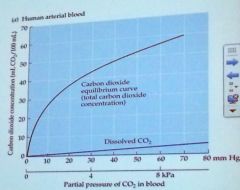![]()
![]()
![]()
Use LEFT and RIGHT arrow keys to navigate between flashcards;
Use UP and DOWN arrow keys to flip the card;
H to show hint;
A reads text to speech;
11 Cards in this Set
- Front
- Back
|
Lets start with the relationship between pressure and volume. When volume increases...
A) Pressure increases. B) Pressure decreases. C) Pressure is unaffected. |
B) Pressure decreases.
|
|
|
At high altitude O2 is scarce, but it still makes up the same proportion (~0.21) of the atmosphere that it does at sea level. What should be true of O2?
A) The partial pressure of O2 is the same at high altitudes as it is at sea level, but molar fraction is smaller. B) The total pressure of the system at high altitudes is the same, but the molar fraction of O2 is smaller. C) The molar fraction of O2 is the same at high altitudes, but its partial pressure is smaller. D) Both the molar fraction and the partial pressure of O2. |
C) The molar fraction of O2 is the same at high altitudes, but its partial pressure is smaller.
|
|
|
What kind of animal can succeed without a circulatory system?
A) A fast one. B) A thin one. C) A big one. D) An invertebrate. E) A segmented one. |
B) A thin one.
|
|
|
What is the function of blood?
A) To increase pressure on the vessel walls. B) To regulate salt balance in the body. C) To make the local environment of each of our cells the same. D) To transport nervous system signals. E) To give the heart a job in addition to love. |
C) To make the local environment of each of our cells the same.
|
|
|
Which of the following makes up the largest fractional volume of vertebrate blood?
A) Plasma. B) Red blood cells. C) White blood cells. D) Coagulants. E) Love. |
A) Plasma.
|
|
|
If you live in Florida, your hematocrit is 0.42, and you move to Denver (the mile high city), what hematocrit level should best help you to acclimate to the new environment?
A) 0.45 B) 0.42 C) 0.40 |
A) 0.45
|
|
|
Where in the cardiovascular system would you expect to find the highest concentration of CO2?
A) The lung capillaries. B) The arteries that go to the brain. C) The veins that come from the lungs. D) The tissue capillaries. |
D) The tissue capillaries.
|
|
|
Most CO2 in the blood is in the form of....
A) Carbon dioxide. B) Carbonic acid. C) Bicarbonate. D) Calcium carbonate. E) Carbonite. |
C) Bicarbonate.
|
|
|
How is CO2 transported across the systematic tissue capillary endothelia?
A) As bicarbonate via an anion exchange protein. B) Simple diffusion. C) CO2 ATPase. D) Vesicle fusion. |
B) Simple diffusion.
|
|
|
Where does the catalyzation of CO2 to bicarbonate take place?
A) In red blood cells. B) In white blood cells. C) Outside of the blood in the extra cellular fluid. D) In the blood plasma. E) A+D |
E) A+D
|
|

The graph shows two curves: Dissolved CO2 and total CO2 concentration. Why are they so different?
A) The total CO2 concentration includes bicarbonate. B) Dissolved CO2 is limited by the partial pressure of CO2. C) The total CO2 in the blood includes that attached to hemoglobin. |
A) The total CO2 concentration includes bicarbonate.
|

